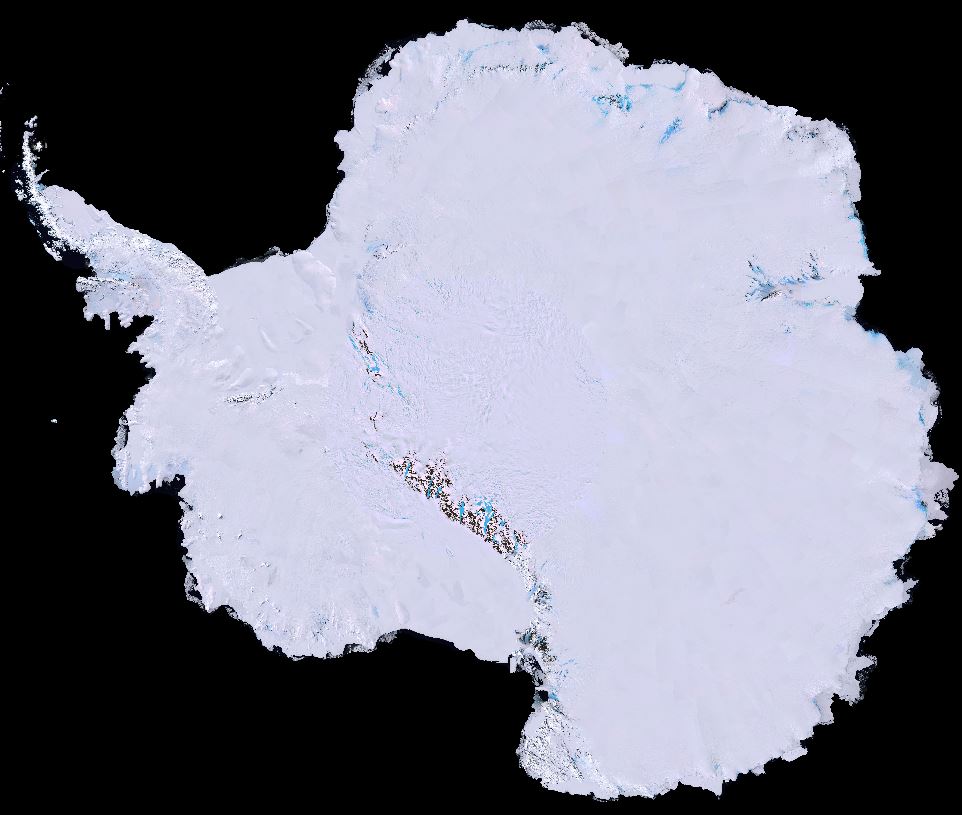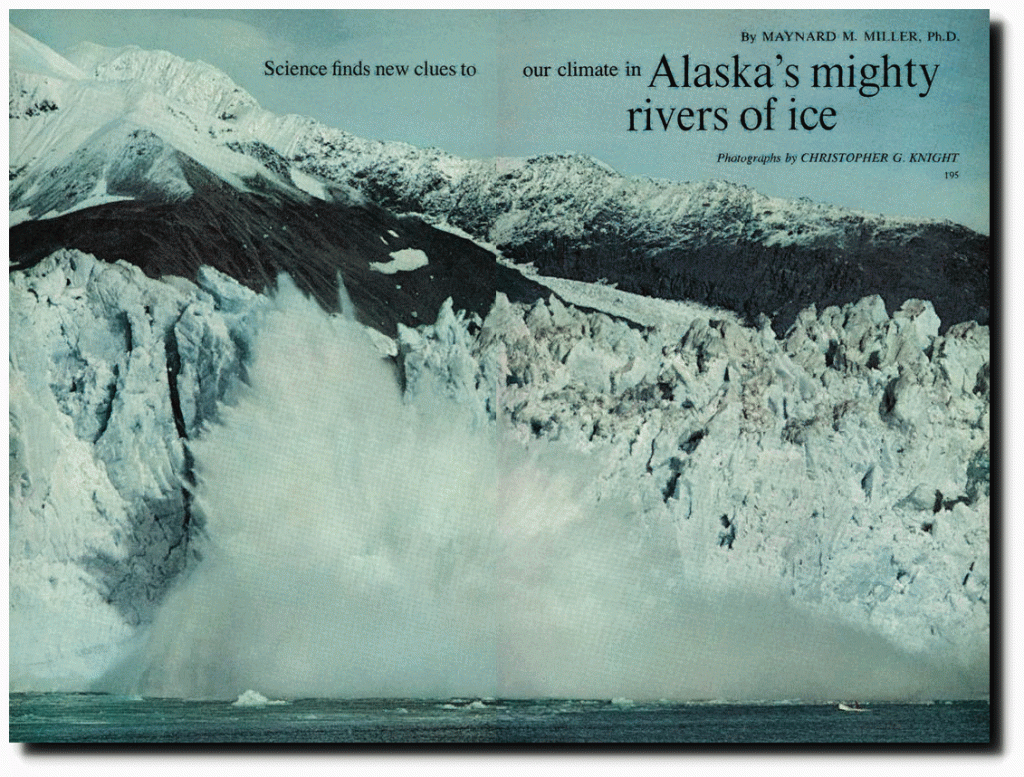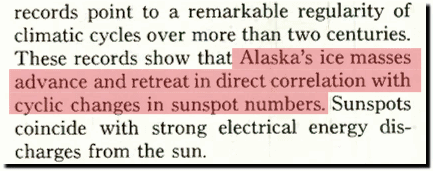New Paper: Glacier Melt Rates Were Up To 3 Times Greater, Faster During Early 20th Century
75% Of Total Modern Glacier Melt Occurred Before 1950
“[T]he retreat of the glaciers after about 1925 became rapid. It was almost entirely during the [pre-1950] twentieth century warming that the Alpine glaciers disappeared from the valley floors up into the mountains. Similarly great retreats occurred in Scandinavia, Iceland, Greenland, in the Americas, and on high mountains near the equator.” — H.H. Lamb Climate, History, and the Modern World (1982), pg. 248
A new scientific paper indicates that the pronounced warming that occurred during the years stretching from the 1920s to the 1940s melted Northern Iceland glaciers much more extensively and at a far more rapid pace than has been observed in recent decades.
During the 1960s to 1980s, glacier melt rates not only decelerated relative to the 1920s to 1940s, the ice actually advanced in some cases due to decades of cooling. It has only been since about the mid-1990s that glaciers have consistently begun melting again — but with far less alacrity than they did in the first half of the 20th century.
Fernández-Fernández and co-authors (2017) indicate that the Icelandic glaciers they studied melted by more than 1,000 meters (1,062) on average between the late 1800s and 1946. But from 1947 to 2005, these same glaciers only retreated by an average of 272 meters more. In other words, about 75% of the total glacier melt production since the end of the Little Ice Age (the late 19th century) occurred prior to the mid-1940s.
Below are some key points and graphs from the paper.
Fernández-Fernández et al., 2017
Summary:
“The abrupt climatic transition of the early 20th century and the 25-year warm period 1925–1950 triggered the main retreat and volume loss of these glaciers since the end of the ‘Little Ice Age’. Meanwhile, cooling during the 1960s, 1970s and 1980s altered the trend, with advances of the glacier snouts. Stötter et al. (1999) indicate that the coldest period after the LIA was from the early 1960s to the mid-1970s, when temperatures fell to levels equivalent to the warmest recorded in the 19th century. This cooling is the reason given by Caseldine (1983, 1985a, 1985b, 1988) to explain the advance of the Gljúfurárjökull between the mid-1970s and the mid-1980s … Studies of aerial photographs and satellite images show that the glacier snouts have retreated by more than 1300 m on average since the LIA maximum
…Analysis: US biologist’s defense of flawed polar bear predictions is an embarrassment to science
US biologist’s defense of flawed polar bear predictions is an embarrassment to science
A few days ago in a radio interview, a senior US Fish & Wildlife biologist repeated the tall tale that Southern Beaufort Sea polar bear numbers declined in recent years due to loss of summer sea ice. But restating this egregious misinformation does not make it true. The Southern Beaufort population did decline between 2001 and 2006 but it was due to natural causes (thick ice in spring from 2004 to 2006) – it had nothing to do with recent summer sea ice loss and Eric Regehr knows it. There is no evidence that the population decline continued after 2006, so it cannot be said to be still declining. Moreover, the situation in the Southern Beaufort does not support the predictions made by Regehr and his colleagues that polar bear populations will decline precipitously if summer sea ice declines further. My recently published paper demolishes the message of doom for polar bears and the misinformation it’s based upon: it’s free and written in straight-forward scientific language. Crockford, S.J. 2017. Testing the hypothesis that routine sea ice coverage of 3-5 mkm2 results in a greater than 30% decline in population size of polar bears (Ursus maritimus). PeerJ Preprints 19 January 2017. Doi: 10.7287/peerj.preprints.2737v1 Open access. https://peerj.com/preprints/2737/ (pdf here). Here’s an excerpt of the nonsense broadcasted on KNOM Radio Alaska by Regehr and transcribed for their website (29 January 2017) [my bold]: “If there’s a poster child for Arctic animals affected by climate change, it’s the polar bear. … “Putting together all available data, and making some informed projections on the basis of those data, do suggest that there is a high probability that the global population of polar bears could face reductions of up to one-third or greater in the next 35 to 40 years,” said Regehr. One group that’s thriving is the Chukchi Sea subpopulation, which includes Western Alaska and the Russian coast across the water. “The waters are shallow, they’re nutrient rich; there are a lot of seals, ringed seals and bearded seals, out there for the polar bears to eat,” said Regehr. “And so, other studies suggest that, despite the fact that the Chukchi Sea region has exhibited a loss of Arctic sea ice the bears in that region appear to be faring quite well, currently.” But their neighbors to the East, the South …
Russian icebreakers stuck in ‘very heavy severe ice conditions’ in Arctic
Date: 27/01/17
By Ron Clutz, Science Matters
https://rclutz.wordpress.com/2017/01/26/arctic-ice-takes-revenge/
The saga shows that despite all the talk of climate change and warming in the Arctic, thick ice can prevent convoys from crossing the Northern Sea Route in deep winter.

Vessels Kapitan Dranitsyn and Admiral Makarov ‘marooned’ in east for the rest of winter after getting trapped off Chukotka.
Russian Convoy Takes Advantage of Reduced Arctic Ice Extent
In the first such crossing since Soviet times, the convoy had earlier delivered supplies for the world’s first floating heat and power plant to be assembled in Chukotka, Russia’s most easternmost region, after a successful journey from Arkhangelsk to Pevek lasting from 14 December to 7 January.
The ease of the sailing was seen as a sign that climate warming in the Arctic can open up shipping lanes even in midwinter. From the Siberian Times, Blow to Northern Sea Route as voyages of two icebreakers are… broken by ice
Reports of Arctic Ice Demise Prove Premature
But, despite significant temperature rises across the northern latitudes in recent years, the vessels became quickly stuck in thick, compressed ice on their return journey.
Initially there were hopes that the icebreakers could force their way out and continue their voyage within a week, and aerial reconnaissance was deployed in a search routes from the ice clog.

They are currently trapped by sudden thick ice around Chukotka’s northernmost cape Shelagsky, some 24 nautical miles from Pevek, in some of Russia’s most exposed waters.
Ruslan Nazarov, chief of Chukotka’s emergencies service, said: ‘The ice around Cape Shelagsky is at 10 points. The ice fields are more than one metre thick. The ice compression is strong and hummocks are higher than 2.5 metres.

Embarrassing But Not Life-threatening
The situation is not critical, Nazarov said, stressing that the regional ministry of emergencies and Chukotka government keep a close eye on it. ‘All the ships have enough fuel, food and all other necessities.’
A spokesman for Rosmorport has announced the icebreakers will delay a return until probably May or early June. ‘The vessels will remain for the winter because of the very heavy severe ice conditions,’ he said.
All the vessel got out of the ice, and three of them – Captain Dranitsyn and the two cargo ships – returned to Pevek. The Admiral Makarov moved further east to continue working for Rosmorport in clearing sea routes.
Officials said the icebreakers could …
Arctic Sea Ice Extent Is Highest In The Past Three Years
…Antarctica Larsen C Ice Shelf Crack Not Related To ‘Climate Change’ – Ice ‘More Stable Than Previously Thought’
By Dr. Sebastian Lüning and Prof Fritz Vahrenholt
(German text translated/edited by P Gosselin)
Image: visibleearth.nasa.gov
A huge crack recently formed through the Antarctic Larsen C ice shelf. The German Tagesspiegel here was fair and did not attribute it to climate change:
A huge iceberg threatens to break away from Antarctica
An iceberg twice the size of Saarland threatens to break off the Larsen-C ice shelf. That’s a rare spectacle. […] ‘The crack is probably 160 kilometers long and 300 to 500 meters deep,’ the project-involved scientist Martin 0′Leary told the German Press Agency on Saturday. A direct connection to climate change cannot be ascertained.”
Read more at Tagesspiegel.
That’s a normal process: Self ice forms, but does not last forever. Time and again cracks form and chunks break off. During the Little Ice Age the shelf ice was more extensive and stable. Before that, during the Medieval Warm Period, the shelf ice melted similarly like today. If one looks at the past 150 years — the global rewarming since the Little Ice Age — then no one wonders that the Antarctic shelf ice retreated 5 meters per day between 1900 and 1930. Over the past fifty years things probably have looked different, as the Antarctic sea water has cooled over the past 50 years. According to Sinclair et al. (2014), the Ross ice shelf has expanded 5%. Apparently the Antarctic sea ice is indeed more stable than previously thought.…
Arctic Sea Ice Grows Back To 2006 Levels
Sea ice charts for 18 January from NSIDC Masie show exactly as much sea ice in 2017 as there was back in 2006 – 13.4 million km^2.
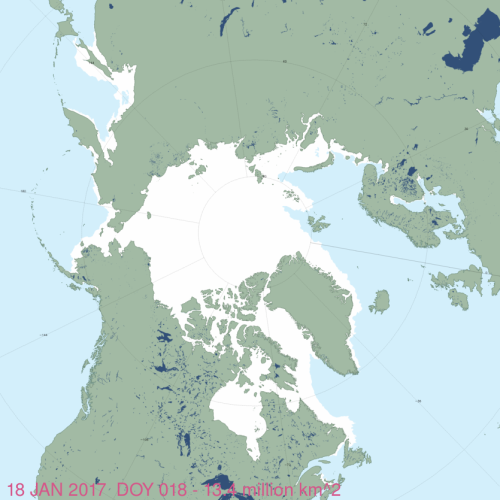
Masie image below from 2006 (enlarged and cropped from archived version and label re-inserted) shows the distribution of ice was slightly different than this year (less in Baffin Bay/Davis Strait/Labrador Sea, more in the Barents and Bering Seas):

Considering only Canada (where 2/3 of the world’s polar bears live), Canadian Ice Service comparative graphs going back to 1971 show average amounts of ice existed the week of 15 January 2017, but considerably more than the estimates for the 1970s (odd that we never hear about that):
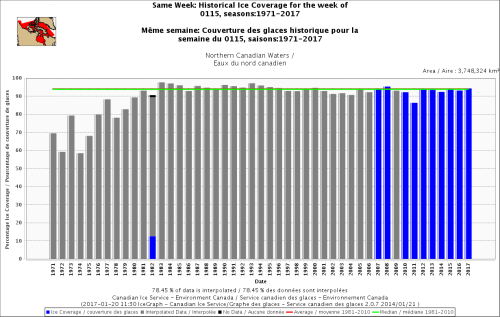 …
…
NPR: Ice Shelf Is Cracking In Antarctica- But ‘it’s probably just simply a natural event…not directly attributable to any warming’
But this is not just another sad climate change story. It’s more complicated.
“A lot of things are going on deep inside the ice,” says Adrian Luckman, a glaciologist at Swansea University in the U.K. He’s also leading a project to track changes in the ice shelf.
Luckman says climate change is certainly influencing this region. Larsen C used to have two neighbors to the north, Larsen A and Larsen B. As the air and water warmed, those ice shelves started melting and then splintered into shards in 1995 and 2002.
But the crack in Larsen C seems to have happened on its own, for different reasons.
“This is probably not directly attributable to any warming in the region, although of course the warming won’t have helped,” says Luckman. “It’s probably just simply a natural event that’s just been waiting around to happen.”
…
Flashback 1967 National Geographic: Sunspots Control Glaciers – ‘Ice masses advance & retreat in direct correlation’ with sunspots
You should, in science, believe logic and arguments, carefully drawn, and not authorities.
– Richard Feynman
Fifty years ago, National Geographic understood that the sun controls glaciers. But that was before they realized they could make money lying about the climate.
National Geographic : 1967 Feb, Page 194
This was back in the days when NASA could still put people in space.
NASA Climate Chief: ‘Russia actually thinks that warming the Arctic is going to be good’
Speaking on the geopolitics of geoengineering the Earth’s climate, NASA Climate Chief Gavin Schmidt says, “Russia actually thinks that warming the Arctic is going to be good for it.”
NASA GISS DIRECTOR GAVIN SCHMIDT: “And, so you’re left with countries that have slightly looser environmental regulations. Say, Russia. Now Russia doesn’t want to do it because Russia actually thinks that warming the Arctic is going to be good for it. So, they’re not going to do it.”
University of Southampton
Global Challenges – Dr. Gavin Schmidt, NASA GISS
January 12, 2017…

